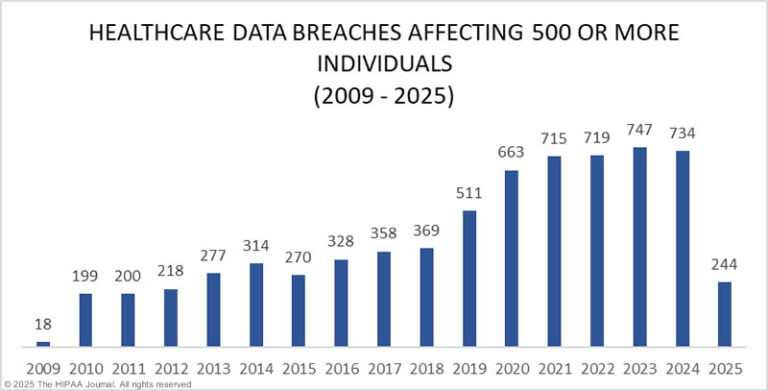Using SaaS solutions, healthcare organizations attempt to cut down operations for efficiency, reduce costs for care delivery, and promote patient-first care delivery. Thus, customers forego the cost of an infrastructure when they move service providers to the cloud, and more funds go into patient care.
But SaaS solutions also have to confront a set of security problems based on the fact that health data is highly sensitive and confidential. Where privacy is concerned, it is of utmost importance that this guides design considerations in digital healthcare platforms and their implementation.
Privacy would then have to be upheld against a target set of adversaries, which in this case would include very sophisticated attacks against healthcare organizations. HIPAA statistics illustrate how breaches are increasing the compromise of healthcare records. Such security breaches mostly take the form of hacking and IT incidents.

(Source: HIPAA Journal)
To remedy such risks, healthcare SaaS startups have adopted a more offensive approach by building privacy into the software architecture from the beginning. Hence, privacy by design.
In this article, we shall see how healthcare SaaS startups may make privacy by design the default for a product’s DNA.
What Is Privacy by Design (PbD)?
PbD is a proactive framework that never waits for privacy risks to emerge. The development framework ensures that privacy and data protection principles are embedded into the technology from the very beginning.
These principles should be incorporated into the software design, network infrastructure, and business practices.
The framework was formed in the late 1990s by Dr. Ann Cavoukian, former Information and Privacy Commissioner in Ontario, Canada. Dr. Cavoikian stresses that privacy should be embedded in the product and system designs right at the beginning and not left as an afterthought.
PbD rests on 7 key principles:
- It emphasizes the proactive stance when actively seeking and preventing privacy-invasive events.
- It ensures personal data is automatically protected as privacy is built into the system as a default setting.
- Privacy is embedded into the design and architecture of the software as it is essential to the core functionality being delivered.
- It allows full functionality related to data security and privacy and aims to avoid unnecessary trade-offs.
- The data is securely retained, and end-of-life disposal is protected and performed in a way that the data lifecycle remains secure.
- It assures that the stakeholders of a transparent approach, where the business practices and technology involved operate according to the stated objectives.
- User interests are respected by offering measures like strong privacy defaults, appropriate notices, and more.
#mc_embed_signup{background:#fff; false;clear:left; font:14px Helvetica,Arial,sans-serif; width: 600px;}
/* Add your own Mailchimp form style overrides in your site stylesheet or in this style block.
We recommend moving this block and the preceding CSS link to the HEAD of your HTML file. */
(function($) {window.fnames = new Array(); window.ftypes = new Array();fnames[0]=’EMAIL’;ftypes[0]=’email’;fnames[1]=’FNAME’;ftypes[1]=’text’;fnames[2]=’LNAME’;ftypes[2]=’text’;fnames[3]=’ADDRESS’;ftypes[3]=’address’;fnames[4]=’PHONE’;ftypes[4]=’phone’;fnames[5]=’MMERGE5′;ftypes[5]=’text’;}(jQuery));var $mcj = jQuery.noConflict(true);

Verizon Small Business Digital Ready
Find free courses, mentorship, networking and grants created just for small businesses.
The post Building for Privacy by Design in Healthcare SaaS Startups appeared first on StartupNation.



